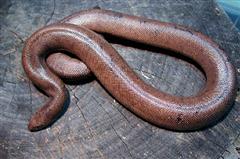Boa - Russian Sand
Black Sand Boa, Dwarf Sand Boa, Central Asian Sand Boa, Mountain Sand Boa Scientific Name: Eryx miliaris
Fri, 4th April, 2025 - 4:29 pm GMT
Sponsor Ads:

Alternative Name
Black Sand Boa, Dwarf Sand Boa, Central Asian Sand Boa, Mountain Sand Boa Scientific Name: Eryx miliarisBasic Info
By maturity, male Russian Sand Boas usually grow to a length of about 18 inches, and females are often 24 inches long. Available in a wide variety of colors and patterns, Russian Sand Boas are quite beautiful. Some have base colors of orange or gray, although most are tan. There is often a pattern of darker colored blotches present, and these are often various shades of brown, reddish, green, or black. Sometimes, lighter colored or orange patches are seen between the darker blotches. Many times, these darker spots fuse as they approach the tail. This creates stripes along the tails of certain Russian Sand Boas. There are even melanistic versions of Russian Sand Boas, called Black Russian or simply Black Sand Boas, especially in the more northern regions of their natural range. Many people consider the Black Russian Sand Boa to be a subspecies (Eryx miliaris nogaiorum) of the Russian. These melanistic Russian Sands are very attractive and much less common. Russian Sand Boas have eyes situated nearer to the tops of their heads than many other Sand Boa species.
Health
Because of their small size, many Russian Sand Boas may be housed in ten gallon terrariums, although very large specimens may need more space. Usually, Russian Sand Boas can do well in a sand or aspen bedding substrate of about two inches in depth. A piece or bark or smooth rock should be present, as this can aid in shedding. The daytime temperature sould be 80 to 85 degrees Fahrenheit, with a basing spot about 95 degrees. At night the temperature should be lowered to about 75 degrees Fahrenheit. Breeding Generally, Russian Sand Boas reach sexual maturity between three and four years of age. To breed them, you should usually hibernate Russian Sand Boas from November to January at a temperature of about 50 degrees Fahrenheit (ten degrees Celsius). After they have been warmed up again, many males will not eat readily until after the breeding process is over. Gravid females will tend to seek out especially warm areas, and it is recommended that they be provided with a basking spot of about 95 degrees Fahrenheit (34 degrees Celsius). The neonates are very small and will require newborn pinky mice for many months. Some are finicky eaters and require small lizards. Baby Russian Sand Boas that are reluctant to feed can sometimes be started on lizard scented pinkie mice.Habitat
They live in hot, sandy areasBehavior
Although less strikingly colored than many boa constrictors, the Russian Sand Boa makes up for this in its easy care requirements. These animals can make good pets for beginners or experienced snake keepers alike, and are often interesting and rewarding captives! Generally, Russian Sand Boas make easy to care for captives, as many eat readily and are often fairly docile. Although they can be aggressive at feeding time, they are generally reputed to be quite tame during handling and rarely bite out of fear. In the wild, they live in hot, sandy areas. Often they shelter during the day and come out to hunt at night.Origin
AsiaHistory
The Russian Sand Boa is native to central Asia, where it inhabits desert areas from southern Russia, Kazakhstan, Turkmenistan, Iran, Mongolia, and other parts of western China. Russian Sand Boas may often be easily confused with Turkish Sand Boas. Although once relatively rare among western herpetological groups, Russian Sand Boas have become more popular in recent years and numbers of captive breedings are beginning to rise.Common Foods
Russian Sand Boas kill their food through constriction, and often eat small lizards or small rodents.Sponsor Ads:
"Gay" used to be one of the most agreeable words in the language. Its appropriation by a notably morose group is an act of piracy. --Arthur M. Schlesinger, Jr.
Boa - Russian Sand
Coded by: BGID® | ALL RIGHTS RESERVED Copyright © 2000-2025
Disclaimer | Privacy | Report Errors / Contact | Credits


 President of the United States of America - Real Estate mogul, Pageant owner and now one of the most controversial men in political history.
President of the United States of America - Real Estate mogul, Pageant owner and now one of the most controversial men in political history.  Politician, US Vice President and President of the USA - Joseph Robinette Biden Jr.
Politician, US Vice President and President of the USA - Joseph Robinette Biden Jr.  versus
versus  Russia: 'The Evil Empire'? Are they all that bad or is it just the USA trying to portray Russia as bad because they are a world power with land bigger and a society very different from the USA ideal?
Russia: 'The Evil Empire'? Are they all that bad or is it just the USA trying to portray Russia as bad because they are a world power with land bigger and a society very different from the USA ideal?  Global warming has been in and out as the "latest" hot topic for many years. It is, according to modern scientists, the result of man-made industrial pollutants, clearing forested areas, agriculture, etc. But now they are thinking it started way before the Industrial Revolution...
Global warming has been in and out as the "latest" hot topic for many years. It is, according to modern scientists, the result of man-made industrial pollutants, clearing forested areas, agriculture, etc. But now they are thinking it started way before the Industrial Revolution... 
 Corona virus
Corona virus 
 Users with wide screen monitors can benefit from more content on every page.
Users with wide screen monitors can benefit from more content on every page.